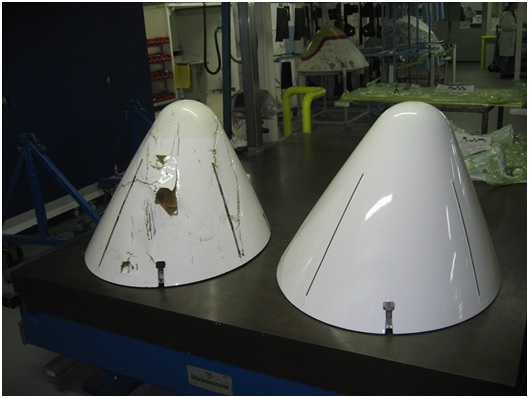
And there are a lot of planes flying in the air in our modern day society. It has been estimated that each commercial airplanes gets on average hit by lightning more than once a year.
Though this is for commercial airplanes, it seems like smaller airplanes, like private jets and small planes are less struck because they are smaller, and usually avoid bad weather. So one might be concerned on what happens when an airplane is hit by lightning.
Fortunately, this is something airplane manufacturers know how, and airplanes are made to handle such events. The last time a plane was taken down by lightning was in 1967. Since then the traffic has vastly grown, and no plane has crashed due to lightning.

When a plane gets hit by lightning, there is an entry point (where the lightning actually strikes the plane), and an exit point (where the lightning goes out of the plane and continues its way to the ground).
Most planes being constructed out of aluminum (a very light metal, a property that is very interesting for producing aircrafts), which is a conductive material, lightning travels on the outside skin of the plane, never getting in. So if a plane is struck by lightning, it will never enter the cabin, where the passengers and crew are located.
Engineers make sure there are no gaps in the metal skin so that wherever the lightning strikes, it will just travel around the skin. Electrical components are very delicate parts of an airplane, and do not handle excessive electrical charges.
So they need to be shielded or grounded (in an airplane, this means connected to the conductive skin). Also nonmetal pieces have metallic/conductive parts in them in order to properly conduct lightning.
Lightning can strike the airplane anywhere on its surface, but it often gets out by the rear parts of the plane, or the sharp edges like the wing tips. This is why special pieces called static discharge wicks are placed at end of the airplane, like for example: the leading edge of wings, in the wingtips, on the rear end of the fuselage and on the rudder. Their purpose isn’t only for lightning.
An airplane going through air is going to charge itself, getting electrons from the atmosphere. This is caused by the friction between the plane and the air surrounding it. So the airplane is going to charge itself, and these wicks are here to dissipate this excess of electrons. In case of a lightning strike, they also allow the lightning to go through them.

Here are some static discharge wicks placed on the leading edge of a wing tip on a B737
All of these measures are taken, and regulated by authorities. In the US for example, the FAA (Federal Aviation Administration) has strict rules regarding lightning strikes on airplanes. These rules are the strictest for commercial aircrafts, because these are more likely to be struck by lightning. Despite these rules, some non-fatal cases of broken propellers, wings and navigation lights due to lightning strikes have been reported on smaller aircrafts.
Though a metallic skin is great for conducting lightning, some parts aren’t covered in aluminum. The best example of this is the radome. This is the nose of the airplane, and which covers one of the aircrafts radar.
Because of the way they work, radars can’t be used in a metallic cover, so radomes are mostly made out of non-conductive composite materials. But they can still be struck by lightning. To prevent this, lightning diverting tips are put on the radome, that will conduct lightning back to the conductive skin. These diverting tips can be compared to rods on the top of a building.

Two radoms, made of composites, on the new one, the one on the right, we can clearly see the lightning diverting tips
Nowadays, most modern commercial airplanes are made more and more out of composite materials, because these are much lighter. This is a great thing for making overall more efficient aircrafts, but this creates a problem that was once solved. For metallic skin aircrafts, there was no need to add any other component to convey lightning.
Composite material used for airplane fuselages being a thousandth time less conductive then aluminum, a solution had to be found to prevent lightning from taking down these new planes. So engineers have come up with the idea of putting a very thin metallic grid of the surface of the composite skin.
Lightning can then be properly conducted across the entire airplane just like it would have been with an aluminum body. Because of rules and certifications required by the FAA and other agencies, tests are conducted multiples times on scale models to ensure that however lightning strikes the aircraft, nothing would happen to it. This also allows us to know how to better protect sensitive equipment.
Another issue we wouldn’t think of at first is fuel, that can easily burst into flames if ever a spark appears; that’s actually what we use fuel for, just not in the tank. So fuel tanks must be protected from lightning. Because even if it just stays on the outside conductive layer, lightning bolts are so charged, that they heat up the entire airplane. And if any part gets too hot it can turn into flames, if this happens in the fuel tanks, the catastrophe is near.
This is actually what happens in 1967, the last time a plane was taken down by lightning. Nowadays, fuel tanks are thick enough and made out of materials able to withstand a burn through. We also use less vapor producing fuels, to limit the risks of combustion in case of a spark.
All of this makes it safe for a plane to get struck by lightning, even if the bolt can cause some minor damages, like small holes in the wings or the radome. This only means that the parts are going the need repairs, but doesn’t compromise the safety of the flight. In case of thunder, other problems come in, like big turbulences or wind that can shake the plane in dangerous manners. So going through a storm still isn’t the ideal flight conditions, but at least lightning isn’t an issue.